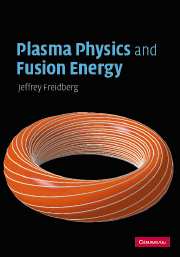Book contents
- Frontmatter
- Contents
- Preface
- Acknowledgements
- Units
- Part I Fusion power
- Part II The plasma physics of fusion energy
- 6 Overview of magnetic fusion
- 7 Definition of a fusion plasma
- 8 Single-particle motion in a plasma – guiding center theory
- 9 Single-particle motion – Coulomb collisions
- 10 A self-consistent two-fluid model
- 11 MHD – macroscopic equilibrium
- 12 MHD – macroscopic stability
- 13 Magnetic fusion concepts
- 14 Transport
- 15 Heating and current drive
- 16 The future of fusion research
- Appendix A Analytical derivation of 〈ς v〉
- Appendix B Radiation from an accelerating charge
- Appendix C Derivation of Boozer coordinates
- Appendix D Poynting's theorem
- Index
- References
10 - A self-consistent two-fluid model
Published online by Cambridge University Press: 14 May 2010
- Frontmatter
- Contents
- Preface
- Acknowledgements
- Units
- Part I Fusion power
- Part II The plasma physics of fusion energy
- 6 Overview of magnetic fusion
- 7 Definition of a fusion plasma
- 8 Single-particle motion in a plasma – guiding center theory
- 9 Single-particle motion – Coulomb collisions
- 10 A self-consistent two-fluid model
- 11 MHD – macroscopic equilibrium
- 12 MHD – macroscopic stability
- 13 Magnetic fusion concepts
- 14 Transport
- 15 Heating and current drive
- 16 The future of fusion research
- Appendix A Analytical derivation of 〈ς v〉
- Appendix B Radiation from an accelerating charge
- Appendix C Derivation of Boozer coordinates
- Appendix D Poynting's theorem
- Index
- References
Summary
Introduction
The discussion so far has focused on single-particle motion in prescribed, long-range electric and magnetic fields as well as short-range Coulomb collisions. No attempt has been made at self-consistency. That is, no attempt has been made to determine how the current density and charge density generated by single-particle motion feeds back and alters the original applied electric and magnetic field. The development of a self-consistent plasma model is the goal of Chapter 10.
Self-consistency is a critical issue. It is important in: (1) providing the physical understanding of the macroscopic forces that hold a plasma together; (2) determining the transport of energy, particles, and magnetic flux, across the plasma; (3) understanding how electromagnetic waves propagate into a plasma to provide heating and non-inductive current drive; and (4) learning how small perturbations in current density and charge density can sometimes dramatically affect the macroscopic and microscopic stability of a plasma.
In developing self-consistent models one should be aware that various levels of description are possible. The most accurate models involve kinetic theory. These strive to determine the particle distribution functions fe (r, v, t) and fi (r, v, t). Kinetic models are very accurate as well as being inclusive of a wide variety of physical phenomena. They are also more complicated to solve and tend to be somewhat abstract with respect to physical intuition. Consequently, with respect to the introductory nature of the book, kinetic theory is considered to be an advanced topic, awaiting study at a future time.
- Type
- Chapter
- Information
- Plasma Physics and Fusion Energy , pp. 223 - 244Publisher: Cambridge University PressPrint publication year: 2007



